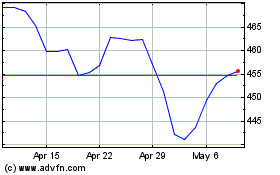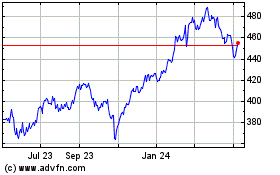For Walmart and Target, the Fed Holds the Keys to Faster Payments
December 06 2018 - 7:29AM
Dow Jones News
By AnnaMaria Andriotis
Walmart Inc. and Target Corp. want the Federal Reserve to help
them get paid in real time.
The retail giants are among the companies urging the Fed to
develop a service to settle interbank transfers in real time, 24
hours a day, seven days a week. Such a service could ultimately
eliminate the lag between when consumers use debit cards to pay for
items and stores receive the funds.
The Federal Reserve in October announced potential actions to
help develop a faster payments system in the U.S., including
creating a real-time settlement service. Walmart, Target and trade
groups including the National Retail Federation have been in
discussions with the Fed regarding faster payments for years,
according to people familiar with the matter.
The system could solve a problem that has long vexed retailers.
Merchants largely rely on card networks including Visa Inc. and
Mastercard Inc. that provide the rails for consumer card
transactions, as well as banks and other companies that process the
transactions and provide funds to the stores. Merchants often have
to wait one to three days to receive funds from debit-card
purchases. Payments for purchases made on a Saturday can take until
Tuesday to arrive.
Action by the Fed could enable merchants and others to develop
faster payment services that allow consumers to pay for items from
their checking account without using existing debit-card rails.
Potential options include payment services integrated into mobile
wallets and merchant smartphone apps with in-store rewards that
incentivize shoppers to use them.
This could become a problem for Visa and Mastercard, which could
lose transaction volume if such alternative payment methods take
off, and card-issuing banks, which reap fees from retailers when
shoppers use debit cards to pay for purchases.
Card issuers received an estimated $14.4 billion in debit card
interchange fees in 2017, up 5% from 2016, according to trade
publication the Nilson Report. Debit-card interchange fees, which
are set by card networks, were capped in 2011 after the 2010
Dodd-Frank law instructed the Fed to lower them for institutions
with $10 billion or more in assets.
A new payments system would face several hurdles to becoming
mainstream. Consumers are addicted to credit cards with generous
rewards, which could make it harder to convince them to switch to
new payment methods. Payment terminals, which merchants have
upgraded over the past few years to accept new chip-based cards,
may need to be updated to accommodate the new system.
What's more, the biggest U.S. banks last year began to deploy
their own real-time payments network, which so far is mostly being
used by companies to pay employees and suppliers. Consumers can
also use RTP to send money between their own checking accounts at
different banks. The RTP network, as it's known, was created by the
big-bank-owned The Clearing House.
"We just think in real time payments we are meeting the need,"
said Steve Ledford, senior vice president of products and strategy
at The Clearing House. "We just wonder why the Fed would need to
come into a market that is already being served."
In an October speech, Federal Reserve governor Lael Brainard
said the central bank has "the unique ability to provide the
infrastructure to reliably settle obligations between banks using
balances at the central bank. As such, we have a responsibility to
serve the broad public interest by providing a flexible and robust
payment infrastructure on which the private sector can
innovate."
The Fed's recent moves follow years of discussion between the
Fed, regional Fed banks, merchants, card companies and banks, among
other parties. The conversations mainly have focused on upgrading
the payments system in the U.S. so consumers and businesses can
receive funds when they are sent and to create a universal system
for money to be transferred in real time between financial
institutions, regardless of their size.
The Fed is soliciting feedback on the proposal through Dec.
14.
A Fed-backed system wouldn't replace credit and debit cards but
could become an alternative to them, especially at large merchants
with a loyal following. Target's debit REDcard, for example, links
directly to a customer's bank account and offers 5% discounts on
card purchases in stores and on the retailer's website.
Retailers increasingly are bypassing card networks with their
own debit-card offerings in an effort to cut down on fees.
Consumers spent some $15.6 billion on merchant-issued debit cards
last year, up 23% from 2016, according to the Nilson Report.
While such purchases accounted for a tiny sliver of the $2.7
trillion in U.S. debit-card transactions in 2017, their growth is a
worrying sign for the banks and card networks.
Merchants and card companies have long had a tense relationship.
Large merchants and trade groups have alleged that Visa and
Mastercard stifle lower-cost competition in payments and
circumvented debit-card regulation. Merchants including Target and
Amazon.com Inc. are likely to move forward with legal challenges to
credit-card interchange fees.
Paying merchants directly out of deposit accounts is commonplace
in markets abroad. In China, mobile wallets Alipay and WeChat Pay
command a large share of consumer payments and are often linked to
money that consumers have in deposit accounts.
Several U.K. banks are testing payments to merchants online that
are linked to consumers' checking accounts via a system powered by
Vocalink, a company recently acquired by Mastercard. In the U.S.,
Vocalink technology will be used to facilitate some real-time
online bill payments beginning next year.
Write to AnnaMaria Andriotis at annamaria.andriotis@wsj.com
(END) Dow Jones Newswires
December 06, 2018 07:14 ET (12:14 GMT)
Copyright (c) 2018 Dow Jones & Company, Inc.
MasterCard (NYSE:MA)
Historical Stock Chart
From Mar 2024 to Apr 2024

MasterCard (NYSE:MA)
Historical Stock Chart
From Apr 2023 to Apr 2024
